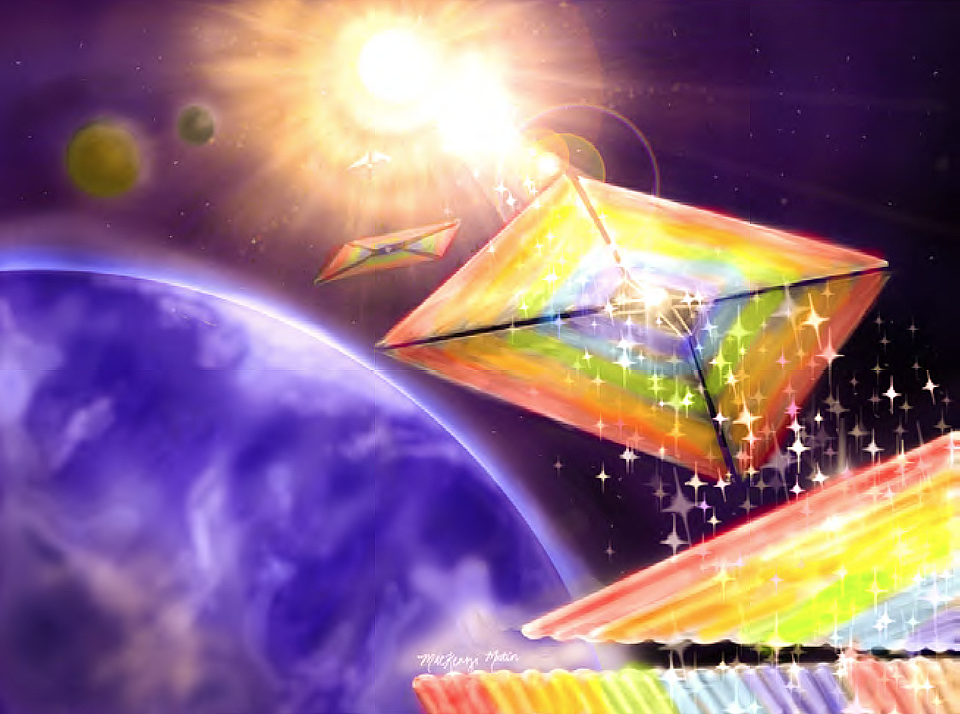Grover Swartzlander
Rochester Institute of Technology
Solar sails are propelled by the free and abundant momentum afforded by sunlight. Propulsion and navigation are achieved by directing reflected or transmitted light away from the natural direction of sunlight. The magnitude and direction of this radiation pressure force depends on factors such as the light deflection angle, the angle of the sail with respect to the sun, and the distance from the sun. Sail areas spanning hundreds of square meters have been envisioned for nearly 100 years for a wide range of space missions that are not practical for chemical rockets. If the momentum transfer efficiency is high and the mass per unit area of the sail is small, large velocity changes may be achieved over time owing to a continuous acceleration. The conventional means of collecting and redirecting sunlight, which makes use of a metal-coated polyimide film, is sub-optimal and unstable because the very large and very thin sail must be rapidly slewed away from the sun line for navigational purposes. What is more stability rigging and attitude control devices add mass to the sailcraft, thereby reducing the acceleration. In principle these limitations may be overcome by replacing the reflective sail with a diffractive one. Our objective is to surmount these shortcomings by engineering optical films using metamaterial principles. Unlike a reflective sail, a sun-facing diffractive sail experiences a component of force perpendicular to the sun line, thereby allowing navigation without sacrificing the amount of solar power on the sail. What is more, the angular deviation of light from a diffractive film may be engineered to provide electronic, rather than mechanical, navigation protocols, e.g. by electro-optic beam steering. The fundamental theory and experimental verification of diffractive lightsailing principals were developed in the Phase I study. The study included an “incubator meeting” of more than 30 experts in solar sailing and metamaterial research, including the team members for this proposal. Together the team will advance the technical readiness level from 3 to 4 or 4.5. A target mission was identified during the incubator meeting and given importance in various NASA Decadal Surveys: A constellation of solar polar orbiters for gathering in-situ heliophysics data such as images at different wavelength bands. To date no direct image of either solar pole has been recorded. A constellation could provide continuous radiometric information across 4π steradians, leading to vast increases of our understanding of the Sun across a wide range of spatial and time scales. The feasibility and cost effectiveness of this novel scheme will be developed in the proposed work. Diffractive metamaterial films allow both inclination cranking, orbit lowering toward the sun, and superior thermal management than a reflective sail, as well as other advantages such as the off-loading of mass and failure risk from mechanical systems such as gyros. The team will design two types of diffractive films: polarization diffraction gratings, and subwavelength refractive structures. Both passive and electro-optically active films having a high momentum transfer efficiency will be designed. The radiation pressure on fabricated films will be measured to verify numerical predictions. Space weathering experiments will also be conducted to assess the survivability to harsh ultraviolet exposure, and electron and proton fluxes. The proposed work will also include a feasibility study to assess the cost, performance, and risk-avoidance advantages associated with a diffractive sailcraft mission on a solar polar orbiting trajectory. Finally, a development roadmap will be crafted, providing sensible stepping stone such as cubesat demonstrations, integration of diffractive components with a reflective sail, and fully diffractive sails for near-Earth, inner solar orbits, and missions to distance stars.































